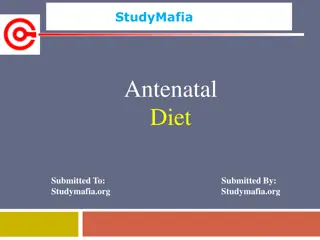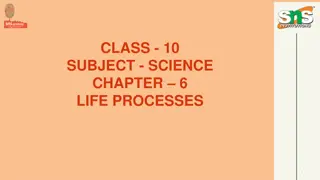Understanding Caloric Needs and Nutrition Recommendations for Americans
Americans are advised to increase their intake of vegetables, fruits, whole grains, low-fat dairy, seafood, and healthy oils. It's important to understand caloric needs based on age, activity level, and gender. The new 9th-grade rule sets calorie limits for school meals. Relying on all three factors for nutrition is crucial, as basing caloric needs on just one or two factors may lead to imbalanced diets. Personalized caloric needs for different genders and activity levels are outlined, emphasizing the importance of a balanced diet and lifestyle choices to meet individual needs.
Download Presentation

Please find below an Image/Link to download the presentation.
The content on the website is provided AS IS for your information and personal use only. It may not be sold, licensed, or shared on other websites without obtaining consent from the author. Download presentation by click this link. If you encounter any issues during the download, it is possible that the publisher has removed the file from their server.
E N D
Presentation Transcript
FOOD FACT As Americans, it is recommended As Americans, it is recommended that we increase our intake of that we increase our intake of vegetables, fruits, whole grains, vegetables, fruits, whole grains, lowfat lowfat milk and dairy products, milk and dairy products, seafood and use oils in place of seafood and use oils in place of solid fats. solid fats.
DEFINITIONS Sedentary Sedentary: lifestyle that includes only the light physical activity associated with typical day-to-day life. Moderate: Moderate: lifestyle that includes physical activity equivalent to walking about 1.5-3 miles per had at 3-4 mph, in addition to the physical activity associated with typical day-to-day life. Active: Active: lifestyle that includes physical activity equivalent to walking more than 3 miles per day at 3-4 mph.
CALORIC NEEDS BASED ON 3 THINGS. Caloric needs change depending on age (discuss 9th grade policy) Age Activity Level Calories in vs. Calories Out (if you burn more, you need more) Boys vs. girls (bodies, muscle, metabolism, processing of food, all different!) Gender
PURPOSE OF THE 9THGRADE RULE Under the new rules, school meals will have calorie minimums and maximums per meal based on the child's age. For kindergarteners to fifth-graders, meals must contain 550 to 650 calories, and for 9th- to 12th-graders, meals must have 450 to 600 calories. http://www.cnn.com/2012/01/25/health/usda- school-lunches/index.html
WHATS THE PROBLEM? Is it completely accurate to just base Is it completely accurate to just base nutrition on one factor? nutrition on one factor? Why are all 3 factors needed? Why are all 3 factors needed? What could happen if we base caloric What could happen if we base caloric needs on only one or two factors? needs on only one or two factors?
YOUR CALORIE NEEDS Gender Gender Activity/ Activity/ Level Level Male/ Male/ Sedentary Sedentary Male/ Male/ Moderately Moderately Active Active Male/ Male/ Active Active Female/ Female/ Sedentary Sedentary Female/ Female/ Moderately Moderately Active Active Female/ Female/ Active Active Age 14 14 2000 2000 2400 2400 2800 2800 1800 1800 2000 2000 2400 2400 15 15 2200 2200 2600 2600 3000 3000 1800 1800 2000 2000 2400 2400 Where do you find yourself? What can you do to improve? (We can ALL improve) What do these calorie needs mean?
2 THINGS TO REMEMBER WITH CHOOSING FOODS Calorie balance Calorie balance (to maintain a (to maintain a healthy weight) healthy weight) Nutrient dense Nutrient dense foods (define ) foods (define )
REDUCE YOUR: Sodium Added sugars Solid fats Refined grains
INCREASE YOUR: Veggies and Fruits Whole grains Seafood Low fat dairy (or fortified soy) Potassium, fiber, vitamin D, calcium (found in veggies, fruits, whole grains and milk products) PHYSICAL ACTIVITY!
REVIEW MYPLATE FRUITS AND VEGETABLES: Half your plate! Veggies: Dark green, red, orange Fruit: eat seasonally, fresh is best! GRAINS: At least are WHOLE! PROTEIN: Make it lean (low fat) and varied. Seafood=8 oz. DAIRY: Low fat (1%), calcium and vitamin D
BURN SOME CALORIES! You must dance/move for 5 minutes. By actively moving (aerobic activity), you will burn about 40 calories in 5 minutes..
6 NUTRIENTS Carbohydrates Proteins Fats & Oils Vitamins Minerals Water
CALORIES=ENERGY Or more fat if you don t burn them! Carbs=4 Proteins =4 Fats and Oils=9 ENERGY!
NO CALORIES, BUT STILL ESSENTIAL vitamins
WHICH NUTRIENTS FOR WHICH GROUP? Carbs Fats and Oils Vitamins Proteins Minerals Water























